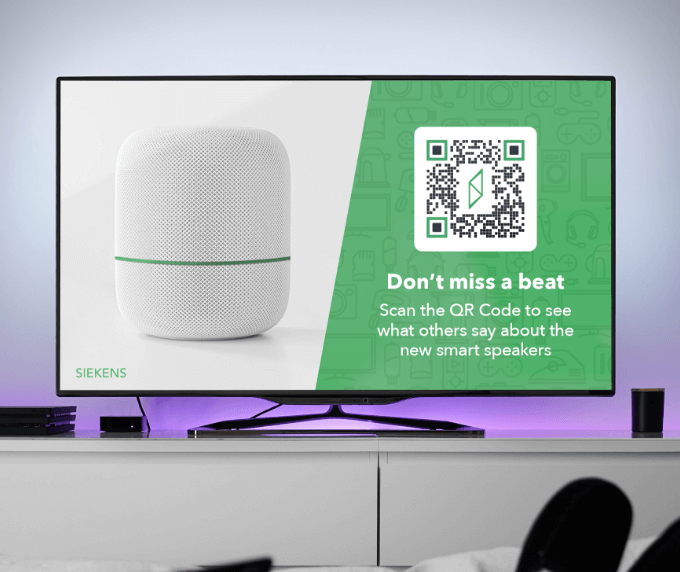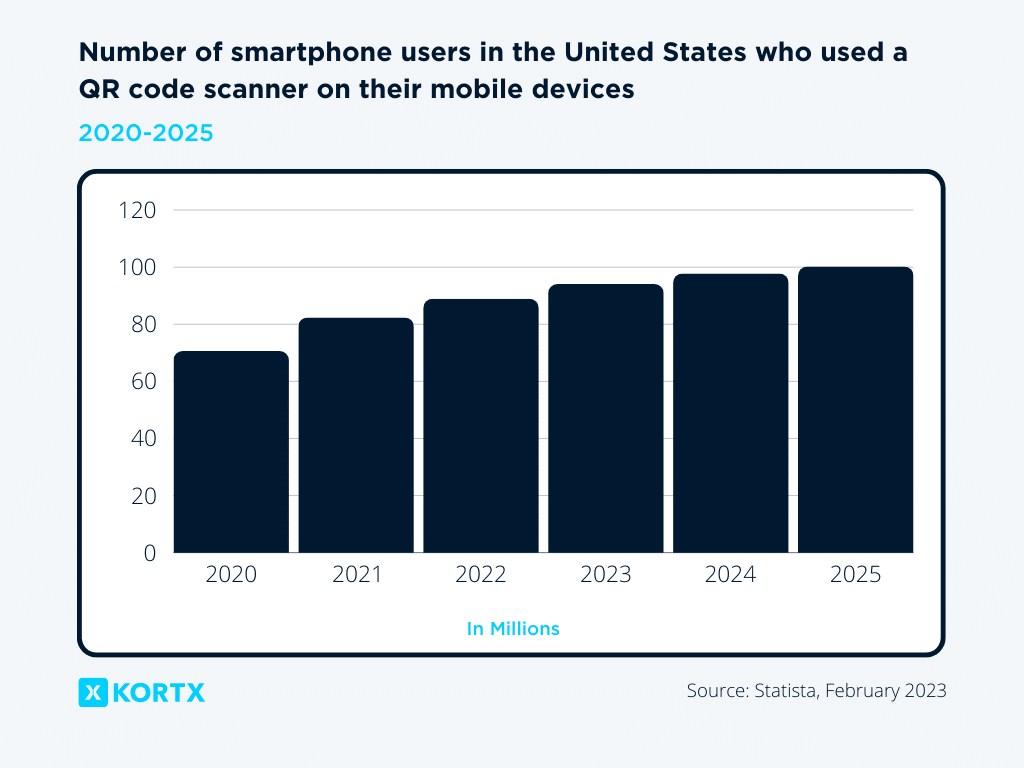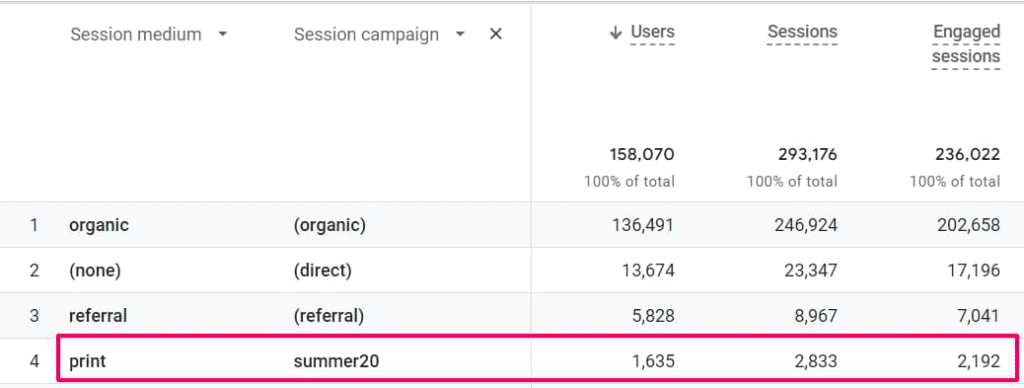With QR (Quick Response) codes, advertisers can convert offline TV engagements to online conversions.
By scanning a code displayed on a TV screen, viewers access additional information, take advantage of special offers, or even make purchases instantly. Depending on how effectively you use QR codes determines whether they are a valuable asset or a costly misstep as there are right and wrong ways to use them.
In this article, we’ll review how QR codes work, their benefits, and best practices to launch your campaign success.
📲 U.S. smartphone users scanning QR codes 2020-2025
In 2022, around 89 million smartphone users in the U.S. scanned a QR code, a 26% increase from 2020, with projections suggesting over 100 million users by 2025.
What Are QR Codes in TV & CTV Advertising, and How Do They Work?
QR codes are black-and-white square barcodes scanned with a smartphone’s camera. Scanning QR codes on TV screens with phones directs viewers to specific online content, linking the ad to a digital experience.

An example of a QR code on a CTV ad from our Jalen Hurts case study.
QR codes aren’t limited to TV or CTV ads. Advertisers can display accessible QR codes in offline campaigns like printed material (brochures, flyers) and other digital advertising campaigns (like Digital Out-Of-Home).
What is the biggest benefit of QR codes in CTV advertising?
“Beyond the effectiveness of QR codes for app downloads within CTV content, the attribution between Smart TVs and mobile devices is paramount. CTV is an in-the-moment medium, and upwards of 70% of consumers are simultaneously engaged on a secondary device while viewing, whether a phone or tablet.
KORTX has leveraged this success and replicated the inclusion of QR codes within In-Clinic DOOH Video campaign activations, allowing users to engage on mobile devices in a waiting room environment, which has proven equally effective. QR codes bridge the device graph attribution gap at the consumer’s convenience.”

What are the Benefits of QR Codes in TV and CTV Ads?
QR codes in TV and CTV ads significantly benefit advertisers and viewers. CTV QR codes provide an interactive path between on-screen content and digital engagement. They also enhance user experience, increase engagement metrics, and provide valuable data insights for marketers.
1. Instant Engagement
Most people keep their smartphones near them throughout the day. QR codes capitalize on this proximity. These interactive ads invite users to investigate your brand immediately as opposed to making them remember a website to search for it later.
Scanning a QR code with a smartphone instantly directs users to digital content like websites or coupons, capturing interest immediately.

2. Trackable Metrics
QR codes also offer robust trackability, providing a valuable baseline to evaluate a campaign’s effectiveness. Gather data on user engagement, such as the number of scans, location, and time when scans occur.
Trackable metrics also provide a baseline for whether CTAs (Calls-to-Action) drive desired actions. For example, by analyzing the time and location of scans, marketers can gain insights into when and where people are most likely to engage with their CTAs.
Also, marketers can use different QR codes for various CTA versions to test which performs better, informing future campaigns. Trackable QR code metrics serve as a baseline by providing tangible data on user engagement, behavior, conversion rates, and demographic insights.
3. Versatility
Marketers can use QR codes for various advertising purposes–from directing customers to a landing page, offering special discounts, facilitating e-commerce transactions, and enhancing the customer experience with augmented reality features.
Marketers can also use them for brand research, increasing membership sign-ups, and form fills to help drive sign-ups.
Using QR Codes for App Downloads
Also, QR codes offer a direct route for CTV viewers to download your app. Scanning the code instantly takes them to the appropriate app store, whether Apple’s App Store or Google Play. This eliminates the need for manual searches and simplifies the download process.

QR codes also offer:
- Immediate access: Viewers can instantly access the app’s store page, making impulse downloads more likely.
- Targeted promotion: QR codes can promote specific features or app updates, driving interest and downloads.
- Broad Compatibility: QR codes work across nearly all smartphones, making them a universally accessible tool.
4. Sleek Design
In the limited space of advertisements, QR codes offer an efficient solution. They maintain a sleek and compelling design, ensuring the message is concise yet valuable to customers. This approach allows ads more room to breathe, emphasizing a compelling call to action through the code.
5. Accessibility
Over 310 million people in the US use a smartphone, and of those, 89 million scanned QR codes in 2022. QR codes have gained popularity not just as a tech trend but as a practical, user-friendly tool accessible to everyone with a smartphone.

With so many users scanning QR codes, businesses and advertisers have an expansive platform to connect with a large and diverse audience.
Case study: Success with interactive CTV & QR codes
Learn how interactive CTV and QR codes, combined with the star power of Jalen Hurts led to a 99% Video Completion Rate (VCR), 7 publisher placements, and 1.17 million impressions.
9 Best Practices of QR Codes in CTV Ads (& Examples)
QR codes engage television viewers to promote a brand’s products and services by directing traffic to their website. Key best practices for QR code campaigns include:
1. Use Prominent Placement
Ensure the QR code is placed prominently in the ad, making it easy for viewers to notice and scan. Consider the ad’s size, positioning, and code contrast against the background.
2. Craft Clear Calls-to-Action (CTAs)
Include a Call-to-Action (CTA) to guide and motivate users to scan the QR code. Your ad should inform viewers what they will gain by scanning the code, whether it’s more information, exclusive offers, or interactive content.

In this Tropical Smoothie Cafe ad, the CTA clearly states, “Scan to order now” compelling users to scan the code.
3. Utilize Trackable Codes
Use unique, trackable QR codes for each campaign to collect valuable data on viewer engagement and the success of your ads.
Google Analytics 4 can track QR codes through customization.

You can set it up to include how many sessions and users you received from scanning the QR code. You can also see how many conversions you received and (if applicable) how much revenue you brought in.
📚 Related Article: How to Create UTM Codes in Google Analytics 4 (GA4): UTM codes are the key to tracking QR codes. Find out how to create them in GA4 today!
4. Track Other Channels Alongside QR Code Campaigns
While QR codes directly link TV advertisements and online platforms, tracking how viewers interact with campaigns through other channels, particularly search, is important. Many viewers prefer to open their browsers and search for the advertised product or service over a QR code.
Here are some suggestions for doing this:
- Track search terms related to your TV ad to gauge its influence on search behavior and identify key traffic-driving keywords.
- Develop a model to understand the contribution of various touchpoints, including QR scans and search queries, to the customer journey.
- Use custom landing pages for your campaign to differentiate between QR code usage and organic search traffic.
5. Offer Exclusive Content or Promotions
Consider offering content or promotions exclusive to TV viewers scanning the QR code. Exclusivity incentivizes viewers to engage with the ad.
6. Test for Accessibility
Before launching the ad, test the QR code across various devices and apps to ensure it works, or your efforts will be wasted. To verify this, simply use your smartphone to walk through each step of the process, from scanning the QR code to receiving a discount or completing an app signup.
7. Do Not Link to Your Homepage
Always connect viewers to a unique deal-specific URL, not your homepage. The goal of QR codes is to guide users to an action. This direct route drops them right where the action is–like a special offer or a specific product page–cutting out the extra hassle of searching through your homepage.
8. Only Use When Linking Isn’t An Option
You should only use QR codes when direct linking isn’t an option. For instance, they’re ideal for TV ads where viewers can’t click a link. However, in digital environments like social media or display ads, where clickable links are the norm, QR codes are redundant and unnecessary.
What’s a common mistake brands make when using QR codes in advertisements?
“QR codes should enhance, not overshadow, the brand message. It’s crucial to ensure they lead to compelling content and are supported by proper tracking and discoverability through SEO and social channels, rather than just redirecting to a homepage.”

9. Integrate with Overall Campaign Strategy
Ensure the QR code’s destination aligns with the broader marketing strategy. Whether it leads to a landing page, video, or a special offer, it should be an integral part of the campaign narrative and complement existing strategies.
🎨 Check out our Ad Gallery here for more creative inspiration!
QR Codes for TV and CTV Advertising: A Complement to Any Creative Campaign
QR codes can enhance user engagement and provide measurable insights into consumer behavior. Paired with TV ads, they offer a creative and engaging way for advertisers to connect with their audience and stand out.
QR code curious?
Our design team can help you incorporate QR codes in your next campaign.
About the Author
Eric Simone is the lead designer at KORTX. Not only is he a design wizard, but he’s also a pro at commercial editing, UX, and project management. Eric has made it his mission to deliver eye-catching designs that pack a punch.
